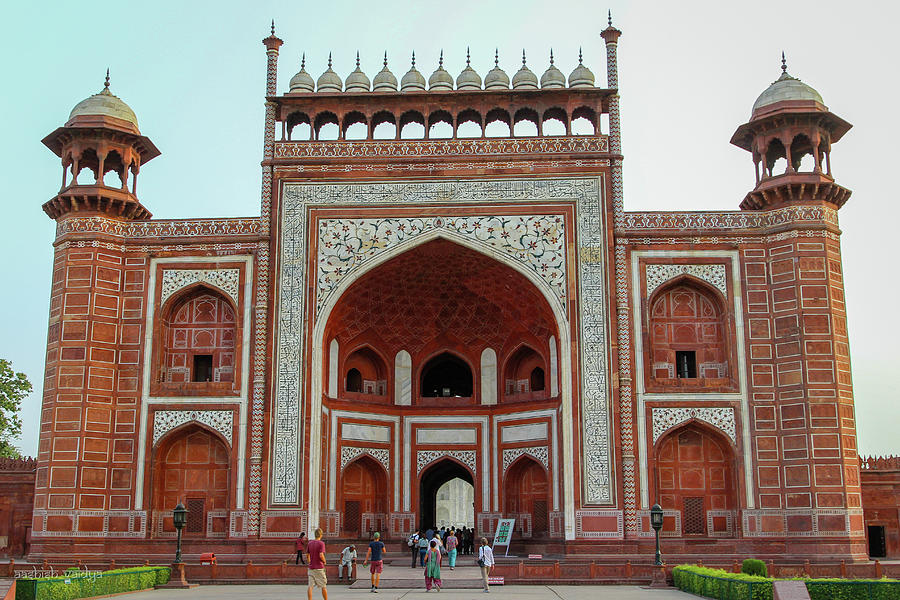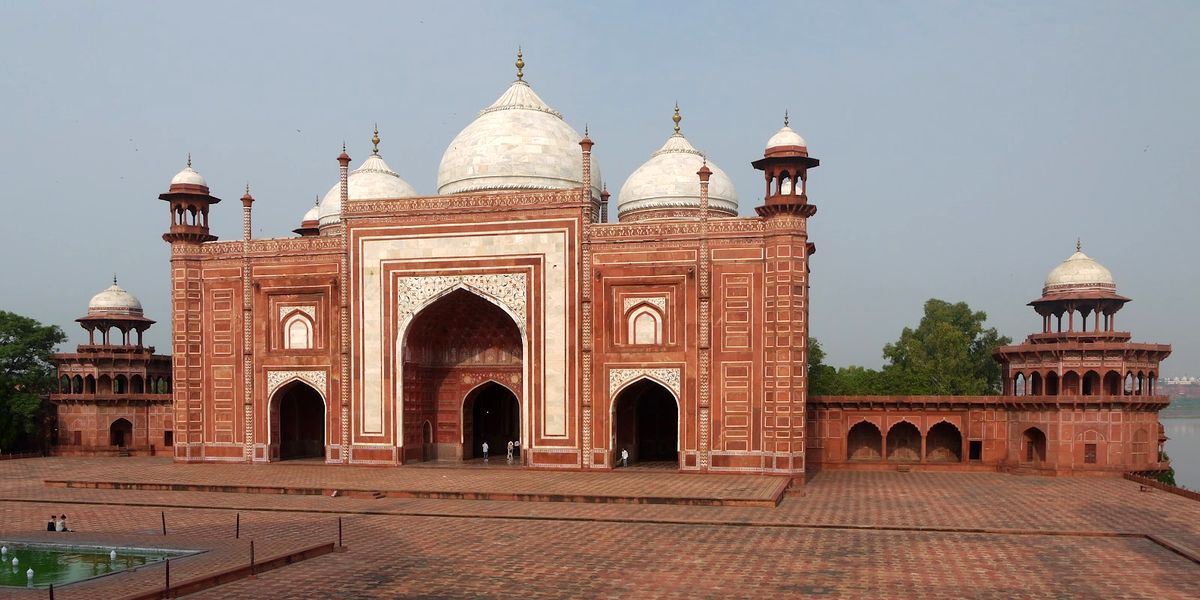There are many different stories surrounding the Taj Mahal History. But no one really knows for sure who designed and built it. Architects have been identified as several different individuals, but most agree that the complex was designed as a cohesive whole and in Mughal building style. Construction of the Taj Mahal began in India in 1632, and it took 22 years to complete. Architects and engineers are not the only ones who believe that Europeans designed and built the Taj Mahal.
The Taj Mahal is the most famous Mughal monument in entire India. It attracts thousands of tourists every year, the only reason why so many people come to visit Taj Mahal is its architectural beauty. The symmetry of the building is astounding and sue will leave you spell bound which you can discover in Taj Mahal Tour Packages. Here in this article we will take a close look at the various architectural components of the world famous “Taj Mahal”.
Entry Gates Of Taj Mahal
The five entry gates of the Taj Mahal history are adorned with motifs that exemplify Hindu design and symmetry. The gate features a red sandstone doorway with an ogival arch. The arched ceiling and open domed pavilions enclose the octagonal towers. The entwined flowers, mostly red lotus, adorn the niche’s sloping sides.
The Taj Mahal’s entrance gate is an impressive structure, adorned with rooms, hallways, and finials. For more than three centuries, these rooms have been unoccupied. The Taj Mahal is designed to create an optical illusion: As you approach the gate, the Taj Mahal seems to shrink in size, and it grows in size as you pass through it. However, this optical illusion is only possible because of the way the Taj Mahal is constructed. The main royal gate leads to a grand forecourt, also called the caravansarai, which was the stopping point for travelers wishing to see the Taj Mahal. The construction of the Taj Mahal’s exterior included the creation of elaborate post-and-beam pulley systems. In addition to the pulley system, teams of oxen and mules provided the lifting power for the blocks. A complex infrastructure was constructed around the Taj Mahal’s water supply. The river water was drawn from the Taj Mahal by a series of purs, while thirteen more purs were raised in the structure
Royal Gate Of Taj Mahal 
The main entrance is sober, open to the four winds, and more like a passageway than a traditional door. Its interior has an octagonal hall whose four sides feature a high, pointed door surrounded by a blind arcade and window in the same shape. The interior of the building is adorned with polychrome inlay art on the dados, cenotaphs, and marble Jhajjhari screens. The interior of the Taj Mahal is equally impressive, and it reflects the style and history of the Mughal empire. The main door is decorated with tomb-like arches and calligraphy. The wall and ceiling are designed in geometric patterns. In the courtyard, the entrance is framed by two red sandstone buildings. These buildings include a mosque and a Jawab. Those with a strong sense of style will be sure to enjoy the Taj Mahal and its architecture.
The Taj Mahal is one of the world’s most beautiful structures and its four-storied main gate is no exception. The intricate, floral-patterned design on the gate’s walls is covered with precious and semi-precious stones. Interestingly, the main gateway is also decorated with Arabic calligraphy on the ogival arch in the center. In addition to the flowers, the gate also displays an Arabic Quran verse inscribed on the white marble surface.
Suggested Tour Packages
- Delhi Tour Packages
- Jaipur Tour Packages
- Taj Mahal Tours
- Golden Triangle Tour Packages
- Taj Mahal Tours Tickets
- Luxury Taj Mahal Tour with Oberoi Experience
Gardens of The Taj Mahal
Located in Agra, the Gardens Of the Taj Mahal are a beautiful example of symmetrical design. They include pathways, fountains, and a reflecting pool. The Taj Mahal is the perfect place for a romantic date and includes stunning views of the city and the surrounding countryside. Listed below are some of the most important things to know about the gardens. When planning your next trip to Agra, you must make sure you have plenty of time to explore this architectural marvel.
The garden of the Taj Mahal has great cultural and architectural significance. Inspired by the Persian Garden of Heaven, this garden has several symbolic and political functions. The Taj Mahal garden also serves as an important landmark in the rise of the Mughal empire on the Indian sub-continent. To begin with, the garden has an important role in the lore of the Taj Mahal. It is said that over 400 species of plants were grown in the garden. Book Maharajas Express
The Gardens Of the Taj Mahal feature 16 separate flower beds, each with over 400 individual plants. Symbolically, the gardens contain two types of trees: the noble Cyprus tree, which symbolizes death, and the fruit-bearing tree, which symbolizes life. Visitors are recommended to visit the gardens at sunrise or sunset to get the most out of the setting. It is possible to see the Taj Mahal from just about any spot, and you’ll be glad you did.
Mosque in The Taj Complex 
The construction of the mosque in the Taj Mahal complex incorporates Islamic, Turkish, and Ottoman architectural styles. The mosque was built by Shah Jahan, who supervised and led its construction. The Taj Mahal is a must-see destination for any tourist visiting India. It is topped with three domes and features a stately exterior. The Taj Mahal mosque is located on the site of a former Jama Masjid.
The building is as much a mosque as it is a monument, which means the mosque and the mausoleum go hand in hand. The mosque is as ornately constructed as the mausoleum and is built from red sandstone. White marble is used for the dome and inlaying. The interior is decorated with mosaics. Visitors can pray and see a play of light and shade in the pool outside.
The entrance to the Taj Complex is a regal affair. The forecourt gardens (or Mihman Khana) are a traditional courtyard feature of Mughal architecture. They served as a place where visitors could rest before entering the main tomb complex. The Taj Ganji quarter is accessed through a southern gate. There are several pillars and arches in the forecourt. Despite its beauty, the Taj Mahal is not quite the mosque that visitors will seek out.
Mehmankhana in The Taj Complex
While visiting the Taj Mahal, make sure to visit the mosque on the west side of the complex. The mosque has the same general structure as the Mehman Khana, but has a small tank where Muslim worshipers wash their hands. This is known as Waju, and is a practice of Islam. The tourists who were there during the drill were surprised by the spectacle. In fact, some were so surprised that they tried it themselves, capturing the moment on video.
The Mehman Khana is an interesting structure. Located at the base of the Taj Mahal, it features floral and marble inlay work. Although not as famous as the Taj Mahal, this structure was built a few centuries after the mausoleum, and served as Mumtaz Mahal’s guest house. As an answer to a mosque, the Mehman Khana was built on the same platform as the mausoleum.
The Taj Mahal complex covers a 17-hectare (42-acre) area, which includes a mosque and guest house. The monument is set within a crenelated wall surrounding the complex. Construction began in 1643 and lasted 10 years. The Taj Mahal was completed by 1653. The Taj Mahal cost 32 million rupees to construct or roughly $916 million in 2020. And while the Taj Mahal may be the most famous attraction in the Taj complex, the complex is also the site of a number of other attractions.
Taj Mahal Mausoleum History and Architecture
The first thing you’ll notice when you enter the Taj Mahal Mausoleum is its unusual shape. Although the entire tomb is octagonal, the sides are regular. The tomb itself is surrounded by four minarets. The most spectacular feature of the mausoleum is its 35-meter-high marble dome. It’s topped by a gilded finial and has a lotus-shaped design, making it seem like an onion. Adding to the mystery of this architectural masterpiece is the dome’s design, which combines traditional Hindu and Islamic elements.
The interior of the Taj Mahal history complex is divided into four chambers, the master bedroom being the largest and tallest. The remaining rooms are empty. The architecture is as symmetrical on the inside as it is on the outside, with the center room occupying the center of the mausoleum. The secondary chambers are octagonal in shape, and the antechambers are symmetrical.
Shah Jahan, the Mughal emperor who commissioned the construction of the Taj Mahal in 1631, had his beloved wife Mumtaz Mahal entombed in the mausoleum. The complex consists of a mosque, living quarters, a reflecting pool, and two additional tombs for Shah Jahan’s wives. The Taj Mahal is now one of the most visited sites in the world, with upwards of four million tourists visiting the mausoleum each year.
The Grave Chamber Inside The Taj Mahal
The Taj Mahal’s interior chamber contains the cenotaphs of Mumtaz Mahal and Shah Jahan. The octagon-shaped chamber has 25-meter-high walls, an eight-sided false interior dome, and four central, upper arches. A series of intricate screens surround the chamber’s roof. A beautiful mosaic of flowers and other motifs can be seen inside the chamber.
The cenotaphs honor the deceased, and the tombs of both Shah Jahan and Mumtaz Mahal are covered in precious gemstones. Muslim tradition forbids the burying of the dead in elaborate ways, but the tombs of these two emperors are decorated with elaborate designs. The cenotaphs are exactly replicas of the gravestones. They can be found on the garden level.

